A couple weeks ago, I introduced you to my embroidery carrot.
You do have embroidery carrots, don’t you? For me, my carrot is always a project I want to work on, but it’s purely for my own pleasure, my own learning experience, just for relaxation and fun. I don’t have to think about the project. Someone else has done all the thinking for me!
For example, this little miniature Cluny tapestry was an embroidery carrot for me. It was just a fun little counted petit point piece, worked on silk gauze. I used it as my “15 Minute” project and as a carrot. When I finished something I had to do, when I got a good day’s work done, or whatever – I’d spend fifteen minutes or more relaxing and stitching on it.
A carrot is a reward. If I was good, I’d reward myself with stitching time on it. And eventually, it was finished!
Well, my carrot this year is Late Harvest, an embroidery kit by Hazel Blomkamp, which I reviewed a couple weeks ago.
Late Harvest is a rather large piece (especially if you compare it to that miniature Cluny tapestry!), and so it requires a good-sized embroidery frame.
My stand-by embroidery frames that I will always love are Evertite stretcher bar frames. You can read all about Evertite stretcher bar frames here – what they are, how they work, and what makes them special.
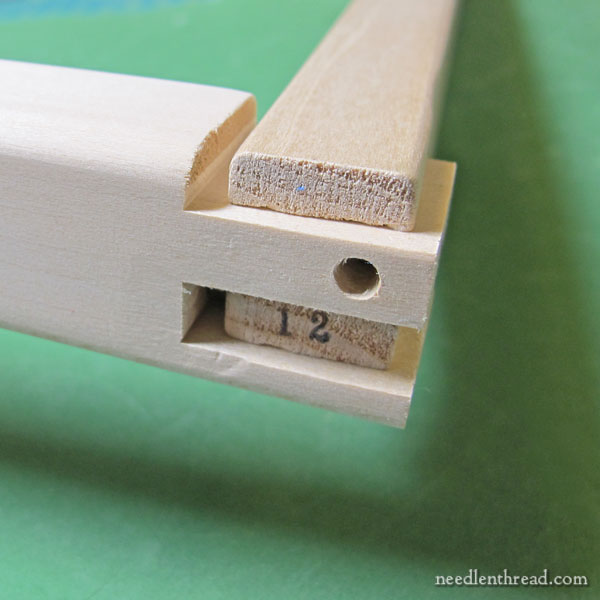
Late Harvest is really only “large” in one direction – it’s wide – and to accommodate the width of the project, I needed to use a set of 22″ long stretcher bars. The other set, to make the short sides of the frame, are only 12″ long.
Evertite stretcher bars are made in many sizes, as far as length goes – from tiny (6″ stretcher bars) all the way up to Really Big – 40″ wide.
The smaller bars (up to 18″) are 3/4″ wide. The bars over 18″ and up to 26″ are 1″ wide on all sides. And although they are different sizes, they are still compatible. So you can easily join a 12″ long bar that’s 3/4″ wide on all sides to a 22″ long bar that’s 1″ wide on all sides.
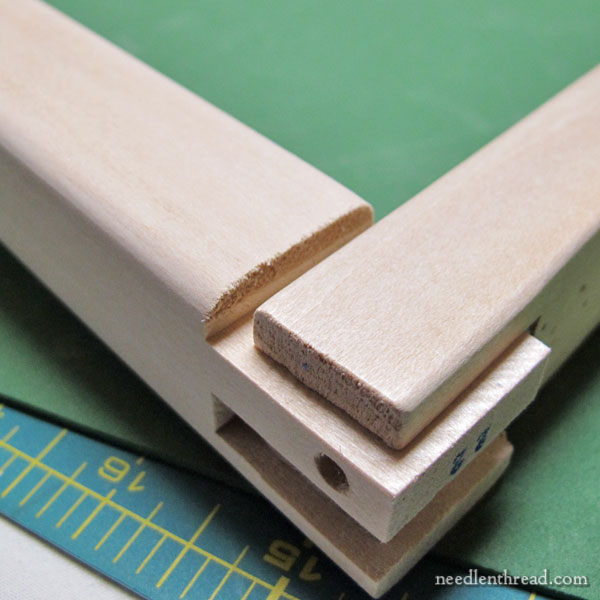
You can see the two sizes of bars here – the thinner 3/4″ wide, 12″ long bar connected to the thicker 1″ wide, 22″ long bars.
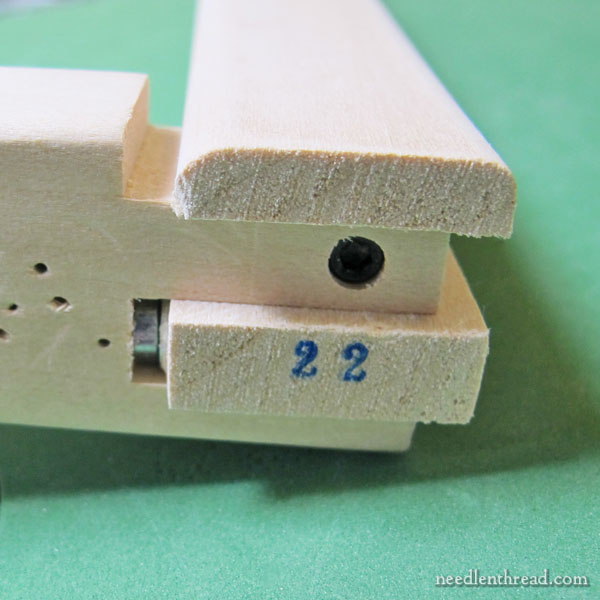
The tightening mechanism – that little screw head you see in the corner joint there – is the signature of the Evertite stretcher bars. It’s what makes them so great! And you can see that it is flush against the joining bar, which is how it should be.
So, even though the two bars are definitely not the same thickness, they still work together.
Incidentally, Evertite frames over 26″ long are 1.25″ wide all around, and they are not compatible with the smaller bars. The longer the bars get, the thicker they must be, so that they keep your fabric taut without warping.
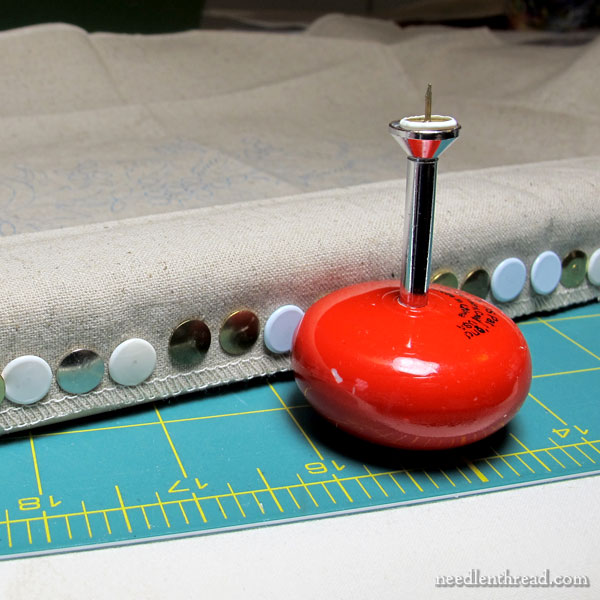
When I use stretcher bars, I tack the fabric to the frame using this EZ Tack-It tool.
If you use stretcher bars of any kind, this tool kit is a great investment! It’ll save your fingers and thumbs! You can find it at any needlework shop that carries stretcher bars, at craft stores like Hobby Lobby, and sometimes, at hardware stores. Look for it! It’s definitely worth having on hand.
The magnetic end of the tacker holds the tack in place, and the shape of the handle makes it very easy to push the tacks into the wood bars. The kit also comes with a little tool for removing the tacks, and with a little container of tacks. I buy my extra tacks in bulk through office supply stores or hardware stores, though, instead of buying the extra EZ Tacks (which are considerably more expensive for the quantity).
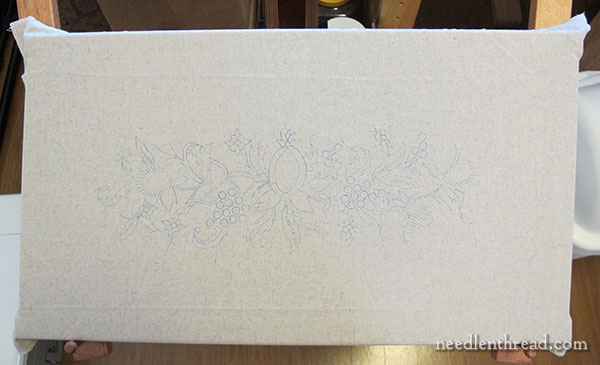
So here’s my carrot, mounted on Evertite stretcher bar frames, sitting comfortably on my Just a Thought needlework stand, which holds it perfectly.
But…it’s not quite ready for stitching just yet.
When I embroider a project like this, I really like the fabric to be drum-drum-drum taut. I like it to be almost hard, it’s so taut.
With this particular project, even though it is stretched and mounted on the stretcher bars, and even though I’ve expanded the stretcher bars a little bit to tighten things up, it still feels a bit spongy to me. There could be two reasons for this: 1. it’s backed with another layer of cotton; 2. the ground fabric is a linen-cotton blend, which tends to be a slightly spongier fabric than 100% linen.
But never fear! I have a solution for eliminating that sponginess and slightly looser feeling. And it works every time!
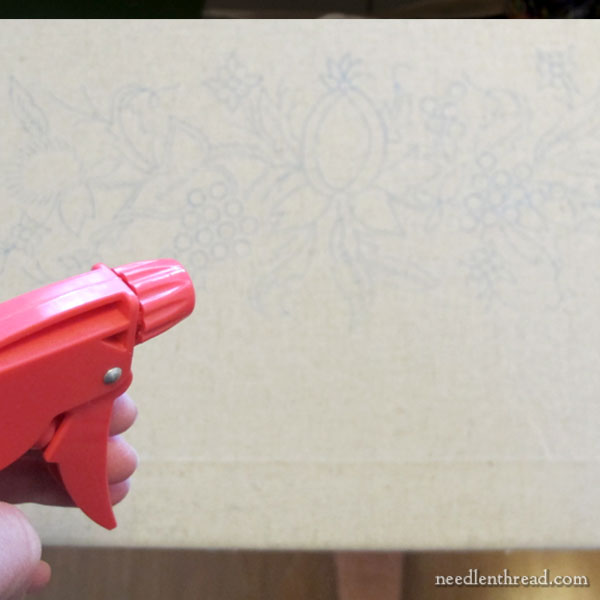
In fact, I often do this with 100% linen, too. I do it with most of my long-term embroidery projects that are on linen (or blends like this) and that are mounted on frames, whether they be Evertite frames, slate frames, or Millenium frames.
After the fabric is mounted, I spray the surface of the fabric with a good mist of water.
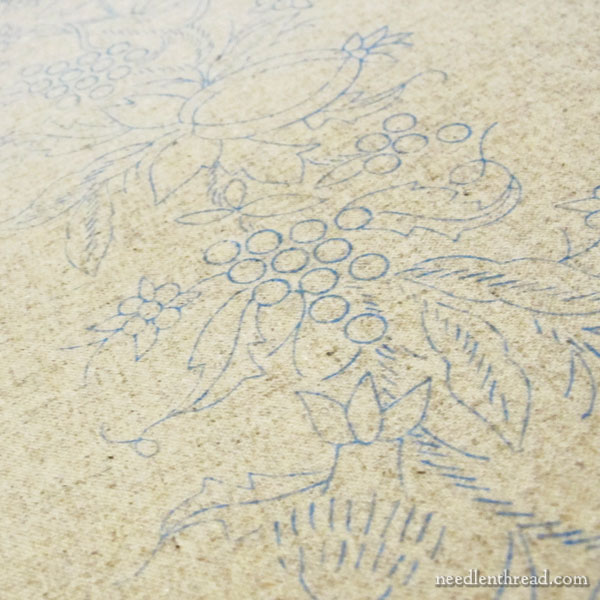
I don’t spray it enough to get it soggy, but just enough to dampen it well.
And then I leave it.
As the fabric dries, it shrinks and tightens up a little extra bit that makes a big difference!
And it worked perfectly with this particular project, too.
My carrot is now ready to go. It’s on its own stand, so I can drag a stool up and work on it when the mood strikes. I can use it to motivate myself, so that when I’ve been particularly good and deserve a carrot, I can take a short break at it.
And I might even work on it when I’m being bad and rebelling against all the other things I should be doing – but Shhhhhhhhh! That’ll be our little secret, ok?







Have lots of fun, Mary and if you get stuck on anything, send me smoke signal. Hazel
Tacking for the novice (or inept = me).
The red mushroom tool is great.
Be very careful with the remover though.
Taking a course, the first instruction was on the importance of the tacking. With the tack remover (which worked very well and is very sharp) imbedded in my hand and my hand now spurting blood on the fabric, I realized that the second instruction about always keeping your fabric clean was now pointless.
Ouch!
Ow!
I’m laughing over here Mary, that you consider a project on 40-count silk gauze “relaxing” but I haven’t had the courage to try it yet, so maybe I should before I laugh? XO
my carrot is hazel’s bountiful season, and this blog was very informative as i am thinking about using this type of frame and now i understand exactly how to mount it to the frame. i love all of hazel blomkamp’s projects and will love seeing your progress on this project. thank you for such a wonderful and informative blog!
my carrot is your “fair Verona” pattern!
I’ve been so immersed in embroidering whenever I can seize a few minutes, even when I should be doing other things, that it probably isn’t fair of me to call it a carrot. it’s more like the cookie jar I keep snatching from. but I’ve had a rough couple of days where I’ve had to leave off entirely… it will be very nice to pick it up again! after I’ve cleaned the kitchen, bathed the child, packed for the weekend trip… oh blah.
I bought the book to get a closer look at this piece and it’s gorgeous. I really hope you can do a good coverage of the stumpwork bits. As a novice, I just can’t wrap my head around it.
I was very interested in today’s post. I love to sew and have been exploring embroidery as an embellishment to clothes, particularly linen.
Typically I like to leave the fabric to be embroidered in a large square format and just outline (with pencil) the areas that I will eventually cut into the shapes required for sewing.
Using the process you describe, I am wondering about the condition of the end product. When embroidering is done and removed from stretchers/hoop, is the fabric stretched beyond repair or does a soaking in cool water resolve any issues?
So far I have only embroidered very small motifs and barely needed to put it in a hoop. I would like my next project to include a fully embroidered yoke but am a little nervous about what it will look like when I take it out of the frame. Thoughts?
Funny – I’d never heard the term “carrot” before.
I can’t wait to start seeing this project develop. It’s not really my personal taste so I won’t be working it with you, but it will be exciting to watch you stitch it – always is!
Besides the Evertite stretcher bar frames, do you know any other kinds of stretcher bars? If so, would you tell me what they are and where to find them? The Evertites look great, I just can’t necessarily afford them.
Sarah
Dear Mary
I remember you embroidering the miniature cluny tapestry did you get it framed and is it on your wall. I like the EZ Tack-It kit but it’s unavailable here in the Uk. I think you deserve your carrot whenever the mood takes you. I really like the idea of spraying your fabric at the start of a project to make it drum tight, I will remember this for future projects it such a good idea. I hope you enjoy your new project and please keep us informed of your progress would love to hear all your tips and techniques on it. Thanks for sharing your new project with us and for all your good advice on setting up a project.
Regards Anita Simmance
Hi Mary,
Now that you’ve had your Millenium and Evertite frames for a while, what are the factors that make you choose one over the other for a particular project?
Kind regards,
Megan
Hi Mary,
I have never heard of the water spray to tighten the fabric. Old horses can learn new tricks. Thank you.
ji
Waffling, wavering and wishing I weren’t so wanton with WIPs. Will watch, weaken and …oh! What’s a good “w”ord for justifying purchasing the kit?
I’m really looking forward to watching this project progress, Mary! I have a question for you regarding framing. I, too, like to have my fabric really, really tight in the frame. I can get it that way upfront but it never seems to stay that firm, especially on a larger project, even when I’ve pre-stretched my fabric. Does that happen to you and if so, do you re-frame or re-spray with water or ??? When I use a hoop the fabric seems to lose that tightness almost immediately but I don’t want to re-hoop every 15 minutes. Am I doing something wrong with my stitching perhaps?
Good morning Mary. I was so ill yesterday I never even brought up my computer, so I am catching up today, altho still not “up to par”. I somehow either missed the post on the miniature Cluny project or have totally forgotten (I have a TERRIBLE memory.) So I am going to read it (again? LOL) as well. It looks like something I would love to learn more about.
Also, thanks for the tip about spritzing the fabric (wonder if that will work with my cotton, going to try). I know about that with brown paper backing on paintings, etc. Never thought about trying it with fabric! You always have such good tips and ideas. Thanks.
Taking a break from Saturday ‘busy-ness’ to read today’s post. I understand it’s recommended that when working with a hoop, during the time the ‘piece’ is at rest, to relax the tension to avoid overstretching the linen and leaving a permanent ‘ring’. Why does leaving a piece in a frame (for a long period of time, say 6 months) not incur damage to the fabric?
(Hope you see this, I’m really puzzled).
I love the Evertite stretcher bar frames except when I am using silk. I just finished a project and the tack holes were a problem as well as the “run” the tacks make in the silk. Any suggestions for using them with silk?
Hi, Regina – yes, run marks can be a problem with silk, though it depends on the type you use. I find a heavier silk satin works pretty well. You might invest in smaller tacks, too – the ones that come in the kits for setting up frames are very thick, compared to regular thumbtacks.
Mary,
Thank you for the quick response. I am using Duponi silk with a backing. I will try the smaller tacks. I really prefer the frames to using a hoop and having to re-hoop overtime I work on the piece.
Thanks again for all you share. Embroidery has become part of my trilogy of loves…tapestry weaving, bobbin lace and embroidery.
My husband is a woodworker and we have collaborated a couple of times with boxes he makes and embroidery I make and plan on doing more.